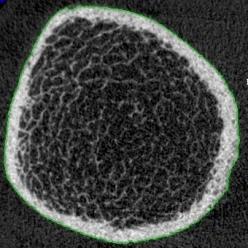Welcome to the ASBMR 2014 Posters SA0023 and SU0022!
Full resolutions versions of our posters are available to download here:
Corresponding Author: Matthew D. Difranco matthew.difranco@meduniwien.ac.at
Corresponding Author: Alexander Valentinitsch alexander.valentinitsch@tum.de
ATLAS-BASED CORRELATION OF LOCAL TRABECULAR DIRECTIONALITY AND DEFORMATION WITH SERUM MARKERS OF BONE TURNOVER IN LUNG TRANSPLANT RECIPIENTS IN A LONGITUDINAL SETTING
L. Fischer, A. Valentintisch, T. Gross, D. Kienzl, C. Schueller-Weidekamm, F. Kainberger, J. Patsch, G. Langs, M. D. DiFranco
Non-invasive assessment of changes in bone microarchitecture over time can be performed by high-resolution peripheral quantitative computed tomography (HRpQCT). The aims of this pilot study were to develop a methodology for the quantification of trabecular reorganization beyond standard morphometry and to investigate the relation between trabecular reorganization, bone strength as captured by finite element analysis, and serum markers of bone turnover.
HRpQCT baseline and follow-up scans of the distal radius from lung transplant (LuTX) patients were obtained (n=33, 15±5 month mean interval). Serum markers (CTX, OCN) were captured at each time point. Finite element analysis (FEA) was employed to measure stiffness (k), failure force (Fmax), bone strength (σmax). Manufacturer-provided standard bone morphology parameters were also acquired.
Baseline and follow-up scans were rigidly registered and deformation maps were obtained for each case[1]. Three parameters related to local changes in trabecular orientation and the direction of deformation were obtained: entropy of directionality (ED), entropy of Jacobian (EJ), and symmetric Kullback-Leibler divergence (KLD). All derived parameters were then correlated to the serum, FEA and morphology values on 3D grid-based regions of an atlas generated from the entire study population.
Significant (p<0.05) localized negative correlations between EJ and changes in BMD, k, Fmax and σmax were seen. OCN at baseline showed significant localized correlations with ED (negative) and KLD (positive). CTX at baseline showed localized positive correlations (non-significant) with EJ.
The OCN to ED negative correlation suggest that within the LuTX cohort, region-specific dominant trabecular directionality is observed where OCN, a formation marker, is elevated. The positive OCN to KLD correlation suggests that trabecular thickening is occurring without a decrease in dominant orientation. A positive CTX to EJ correlation could indicate that direction-independent bone loss is observed in conjunction with elevated CTX, a resorption marker.
We have proposed a methodology for discovering localized correlations between image-derived measures of trabecular reorganization and various bone metabolism, biomechanical and morphology markers. Application of this method to a LuTX cohort reveals correlations between trabecular directionality and both local systematic bone turnover and bone strength.
[1] DiFranco M. ASBMR 2013/SA0072
Bone Multi-modal Automated Trabecular Histomorphometry

Funded bx the EU 7th Framework
Team: Matthew DiFranco, Alexander Valentinitsch, Lukas Fischer, Janina Patsch, Georg Langs, Franz Kainberger
Osteoporosis is a disease that affects bones characterized by low bone mass and micro-architectural deterioration. Osteoporosis is an important public health concern, and early diagnosis and treatment indication is a key to effective intervention.
The aim of this project is to move closer to in-situ observation of bone remodelling and microarchitecture. This will be achieved by developing methods for detection of osteoclastic sites and eroded trabecular surfaces in micro-CT, and ultimately HR-pQCT images, using information obtained from bone histology. This project will build on the progress and results of the FELUX/BIOBONE and XBONE projects in order to develop a platform of bone imaging techniques aimed at the realization of image-based bone biopsy.
Recent publications:
Fischer, L., Valentinitsch, A., DiFranco, M.D., Schueller-Weidekamm, C., Kienzl, D., Resch, H., Gross, T., Weber, M., Jaksch, P., Klepetko, W., Zweytick, B., Pietschmann, P., Kainberger, F., Langs, G., Patsch, J.M. (2014). ``Poor trabecular bone microarchitecture, cortical porosity, and low bone strength in lung transplant recipients'', Radiology, Accepted for Publication
